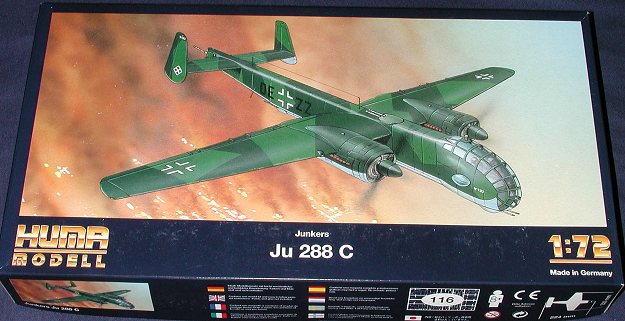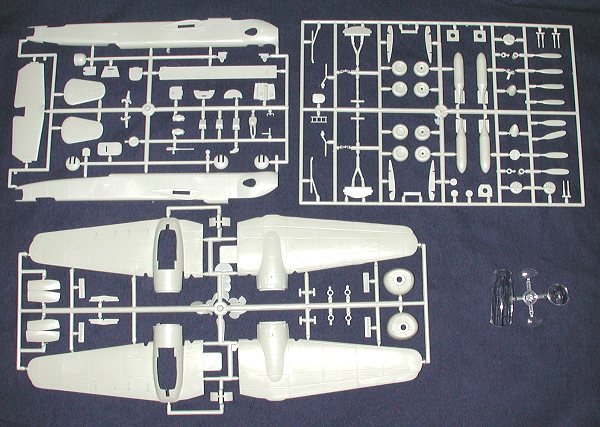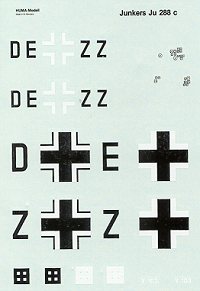
|
KIT: |
Huma 1/72 Ju-288C |
|
KIT # |
6001 |
|
PRICE: |
@$45.00 |
|
DECALS: |
One aircraft |
|
REVIEW & |
|
|
NOTES: |
Sort of short run; see review |

|
HISTORY |
The Ju-288 was initially started as a company project to be a replacement for the Ju-88 then undergoing flight tests. The basic proposal was submitted to the RLM in 1937. It was no surprise that in 1939 the 'B-Bomber' specifications were quite close to what Junkers proposed. Basically, it was for an aircraft with a range capable of reaching anywhere in the British Isles with a 4,000 kg bomb load and a speed of about 500 kph.
The competition was opened to all and proposals were received from Arado, Dornier, and Focke-Wulf as well as Junkers, but it rather obvious from the start that the Junkers plane had a huge head start. Arado submitted the Ar-340 design, Dornier the Do-317 and Focke-Wulf the Fw-161. The Arado aircraft was never built, the Dornier was the most conventional and was given the go ahead as a backup. Focke-Wulf and Junkers were the only two really in the competition and both had aircraft with a number of innovations. In the end, it was the Junkers plane that got all the attention with only a single prototype of the Dornier and two Focke-Wulf prototypes being completed. The Focke-Wulf aircraft had all controls electrically operated. It was a real fiasco and the two prototypes flew only a total of ten hours before being grounded as unreliable. All aircraft were to use the Junkers Jumo 222 engine.
Junkers promised first flight was to be in late 1940 with production getting underway in early 1942. There were a number of innovations including powered turrets for defense and the powerful Junkers Jumo 222 in-line engines of 2,500 hp each. The 222A was a twenty four cylinder engine and the later 222G was a thirty-six cylinder multi-bank engine. Needless to say, they were extremely complex and they never really were reliable. It was the engine which helped to doom the B-bomber project.
Without these engines, the initial prototypes were powered by 1600 hp BMW 801 radials as the airframes were ready well in advance of airworthy engines. You don't have to be Nostradamus to see that the loss of 900 hp per engine meant that the plane would in no way meet its performance goals. To add to the mess, the plane was not very stable and quite difficult to fly. It wasn't until late 1941 that flight ready Jumo 222A engines were installed in the fifth prototype. The new engines still didn't meet the expected horsepower and were quite fuel thirsty as well. Despite increases in wingspan and other improvements, the plane still did not meet expectations. To add to things, it was fitted with dive brakes as the RLM still required every bomber to be able to be a dive bomber as well.
After 15 Ju-288A and 288B prototypes had been built and flown, it was decided to can the 222 engine and try the new 24 cylinder Daimler-Benz DB.606 engine for the Ju-288C model. The C model was enlarged from the previous aircraft and had an increased defensive armament over the others. The first C prototype, the V102, flew in late 1942 with the DB.606 engines and while satisfactory, still did not meet the requirements set down three years ago. Despite this, Junkers was ramping up for full production on the aircraft. Prototypes V104, 105 and 106 used the DB.610 engine which was the same power plant used on the He-177.
By this time it was 1943 and the RLM had concluded that the requirements were no longer valid. They just could not see putting any more time and effort into a project that seemed to never reach fruition. As such, they cancelled the project, much to the surprise of Junkers. Two more prototypes were allowed to be completed, but the other aircraft under construction were scrapped on the assembly line. In late 1944, several of the prototypes were outfitted with 75mm guns in pods and destined for the Eastern front. Actual use of the aircraft in combat is unknown. Your editor has never seen any photos of aircraft in combat or even those that have been converted.
|
THE KIT |

After what seems to be years, Huma has finally produced a new kit. And they chose an aircraft that fits well into my recent interest in Junkers bombers. Huma is one of those companies that straddles the line between short run and high output, 'regular' model kits. For instance, the plastic is a bit soft as with many short run kits. The level of detail is also in the short run category in many cases. The kits also have some flash and ejector pin marks in places that you'd wish they were not! Some of the thicker parts have sink marks in them, however, from what I have seen, they will either be easy to fill or hidden when the kit is constructed.
The kit itself has nicely engraved panel lines and is molded in Huma's greenish-grey, slightly soft plastic. It also has nice injected clear bits that are well molded. Sprue attachment points are a bit close to the parts, so for many bits, you'll have to saw off the parts to prevent damage to them. The kit has a bomb bay and two very large 2,000 kg bombs, however, if you want to see them, you'll have to do some work in the bomb bay area as the doors are not designed to be open. A rather odd way of doing things, but one that can be cured with a razor saw and some patience. In terms of options, you really don't have any other than the bomb bay.
 The instructions are typical of
newer Huma kits. There are two large folded pages. One of them is for the
history in several languages and a nice, full color four-view of the kit to
enable you to install decals. The rest is the usual large exploded views with
smaller sub-assembly construction views. To be frank, the instructions require
you to figure out how some of the parts fit as it is not really all that
intuitive. I can suggest taking your time and doing a lot of dry-fitting if you
are not sure.
The instructions are typical of
newer Huma kits. There are two large folded pages. One of them is for the
history in several languages and a nice, full color four-view of the kit to
enable you to install decals. The rest is the usual large exploded views with
smaller sub-assembly construction views. To be frank, the instructions require
you to figure out how some of the parts fit as it is not really all that
intuitive. I can suggest taking your time and doing a lot of dry-fitting if you
are not sure.
No interior color information is given at all. It is up to the builder to determine if the cockpit area should be RLM 66 or 02. The decals are for the second Ju-288C prototype, V103. Since this aircraft was built in 1942 after the Nov 1941 requirement for RLM 66 cockpits, I'd go with that color. Decals are given for the instrument and side consoles. They are quite flat and have a lot of clear carrier that should be trimmed off before using. I have had good luck with Huma decals so they should work quite well on this kit. Naturally, no real swastika is provided, on the quad-box version that will need some major trimming to use. Head for the aftermarket sheets for this one!
|
CONCLUSIONS |
Previewing kits like this are difficult. You have to take a number of things into consideration. One is that they are not going to meet the expectations you'd have of a Tamiya kit. Yet you still have to point out those areas where builders are going to run into problems. Many of us take into account that we are going to have to put more work and effort into a short run kit than a mainstream model from Revell.
Personally, I really like Huma kits. Every one I have built has been a real pleasure. Much of it is because of the subject as with anything. However, Huma kits do build well. They generally fit where they should and though they need a bit more effort on the modelers part, turn into very nice models when you are finished. Despite my whining about a few minor things, this one is the best so far from Huma and I hope it does well so that they will bring out more of the unusual subjects we have come to expect from them.
Stay tuned.
|
REFERENCES |
Monogram Close-up # 2: Junkers Ju-288, by Thomas Hitchcock, 1974
Review kit courtesy of me and my wallet!
If you would like your product reviewed fairly and quickly by a site that has thousands of visits a day, please contact me or see other details in the Note to Contributors.